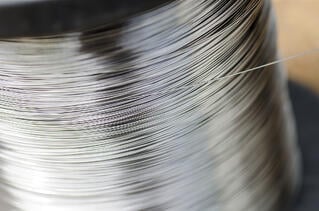 There are many different challenges in ensuring the rapid production of custom parts in any assembly process. One major challenge is getting the parts from one finishing process to the next in a timely manner. This is especially difficult when trying to move parts in bulk.
There are many different challenges in ensuring the rapid production of custom parts in any assembly process. One major challenge is getting the parts from one finishing process to the next in a timely manner. This is especially difficult when trying to move parts in bulk.
In a recent order from a client, Marlin Steel was tasked with not just creating custom parts washing baskets that could hold 60 glasses each, but another container that could be used to store and move up to five fully-loaded baskets at a time as well.
So, Marlin’s engineering team set about designing stainless steel carts with the capacity to safely hold up to 300 sets of glasses when the parts cleaning baskets inside were fully loaded.
Making a custom stainless steel cart to hold cleaning baskets for glasses held a few challenges. Here’s how Marlin’s degreed engineers overcame these challenges:
1: Designing for a Specific Minimum Weight Capacity
One of the most important things in any custom container design, whether it’s a stainless steel wire basket for ultrasonic cleaning, or a sheet metal container for materials handling, is to avoid over-designing the container.
An over-designed container that has excessive amounts of structural reinforcements might be able to take the designated payload extraordinarily well, but the extra materials used in the design mean more time, money, and labor spent on building the thing. In a custom steel container design, this translates into increased costs without improving the utility of the design.
The load in the baskets is always going to be the same sixty sets of glasses, at the same weight. No other, heavier parts would ever be loaded, so spending money on an overwrought frame would be a waste with no ROI.
Marlin’s degreed engineers tested several designs for both the baskets and the steel cart to see which design would use the minimum amount of material while only modestly exceeding the maximum weight requirement.
2: Accounting for Environmental Factors
The specific chemicals used in a manufacturing process, as well as any chemicals that might be in the air, have to be accounted for in the design of any metal container that is going to be used on the factory floor.
For example, some chemicals used in vapor degreasing and other parts washing processes can be highly corrosive, and are often a factor in the design of a stainless steel basket. However, environmental factors such as salt in the air might not be considered, leading to using materials that don’t have enough corrosion resistance in the design of the basket. This, in turn, leads to baskets falling apart from salty air.
By testing for exposure to various environmental factors using virtual physics simulation software, Marlin’s degreed engineers were able to choose a grade of stainless steel for the cart’s design that would withstand the occasional exposure to any corrosives from the client’s parts cleaning process, as well as any other stray chemicals/solutions that might be in the air.
3: Providing Both Plentiful Ventilation and Protection for Parts
In between cleaning processes, the client’s parts needed to be able to dry out sufficiently before being moved. This would require the stainless steel cart to have plentiful ventilation so that liquids on the glasses could be permitted to evaporate or drip-dry without re-depositing on other glasses in the cart.
However, these glasses needed to be protected from accidental impacts and other shocks while the cart would be in motion. Otherwise, fragile glasses could be broken, leading to excessive manufacturing scrap.
Using caster wheels on the bottom of the cart would allow the cart to roll smoothly along a flat manufacturing floor. A basic frame of thick wires and custom-cut sheet metal would provide structural integrity to prevent glasses in the cart from being directly impacted if there were a collision, but still allowing enough space between glasses in the cart for air to pass freely, aiding the drying process.
4: Ease of Movement
Speaking of wheels, using free-rolling caster wheels on the bottom of the cart would allow for easy movement, especially when turning corners. Handholds at the top of the cart provided easy grips so that workers could have better handling and control.
This makes moving a fully-loaded cart from point A to point B easier, reducing the risk of mishaps that could lead to broken glasses.
Furthermore, both the cart and the custom parts cleaning baskets it was designed to hold needed to be designed in such a way that inserting and removing the baskets was easy, but that would also keep the baskets from just sliding out during movement.
The faster that baskets could be loaded/unloaded from the cart, the less time would be consumed on moving parts loads from one process to the next.
These are just a few of the design considerations that went into both the stainless steel cart and the custom parts cleaning baskets that Marlin Steel designed for the client. Ultimately, each one is just a means of helping boost the client’s productivity by:
- Reducing time between processes
- Eliminating scrap/waste of product
- Ensuring that containers will not fail during use



.gif)


